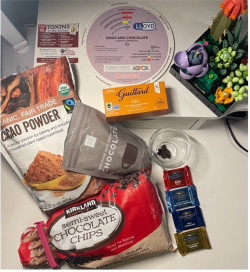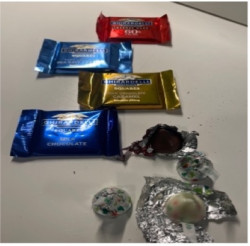
Chocolate and our pets – Don’t let them get chip-faced for Valentine’s Day!
February promises many sweets, especially chocolate. With Valentine’s Day on the horizon, many pets, let’s be honest, dogs, are typically the ones to find the hidden chocolate, gorge, and get themselves into trouble. Since chocolate is a beloved treat by many people, it is found in most homes. In fact, the  picture (side) was just what I could find on the first pass in my kitchen; some cacao powder, Belgian hot chocolate powder, chocolate-covered coffee beans, and raisins, semi-sweet chocolate chips, bakers’ chocolate, and some assorted chocolate squares (60% dark chocolate, milk chocolate, and dark chocolate with sea salt caramel). In other words, lots of chocolate from the holidays and, with Valentine's just around the corner, my chocolate collection will only grow.
picture (side) was just what I could find on the first pass in my kitchen; some cacao powder, Belgian hot chocolate powder, chocolate-covered coffee beans, and raisins, semi-sweet chocolate chips, bakers’ chocolate, and some assorted chocolate squares (60% dark chocolate, milk chocolate, and dark chocolate with sea salt caramel). In other words, lots of chocolate from the holidays and, with Valentine's just around the corner, my chocolate collection will only grow.
The problem is chocolate is toxic to dogs and cats. Actually, many species are susceptible. Deaths have been reported  in livestock-fed cocoa byproducts, and in animals consuming mulch from cocoa bean hulls.1 However, since dogs tend to be the ones that scavenge and get into things more, they are most often the ones that suffer from the temptation of chocolate. This is evidenced by the fact that chocolate was # 4 on the ASPCA Animal Poison Control Center Top 10 Pet Toxin list.2 In fact, in 2021, the ASPCA Animal Poison Control Center averaged over 103 cases of chocolate ingestion per day; that is 1 case every 15 minutes!2 The part of chocolate that is a problem are the methylxanthines; theobromine and caffeine.1,3 The amount of methylxanthines varies in chocolate due to the
in livestock-fed cocoa byproducts, and in animals consuming mulch from cocoa bean hulls.1 However, since dogs tend to be the ones that scavenge and get into things more, they are most often the ones that suffer from the temptation of chocolate. This is evidenced by the fact that chocolate was # 4 on the ASPCA Animal Poison Control Center Top 10 Pet Toxin list.2 In fact, in 2021, the ASPCA Animal Poison Control Center averaged over 103 cases of chocolate ingestion per day; that is 1 case every 15 minutes!2 The part of chocolate that is a problem are the methylxanthines; theobromine and caffeine.1,3 The amount of methylxanthines varies in chocolate due to the
variability of the cocoa bean and the processing required for making different types of chocolate products. The general rule is that the darker the chocolate, the more theobromine, and the higher the risk of toxicity. Table 1 outlines different types of chocolate you might find in your house, or as a Valentine's treat. Depending on what is ingested will determine how much of the toxin was consumed and how much risk is involved.
Table 1: Selected sources of chocolate and reported concentrations of theobromine1,3
|
Product/ type of chocolate |
Concentration of theobromine (mg/oz) |
|
Cacao beans |
300-1500 |
|
Unsweetened baking chocolate |
390-450 |
|
Cacao powder |
400-800 |
|
Cacao bean mulch |
56-900 |
|
Cacao bean hulls |
150-255 |
|
Dark semisweet chocolate |
135-160 |
|
Milk chocolate |
44-64 |
|
White chocolate |
0.25 |
As an example, determining how much of methylxanthine is in the 60% cacao chocolate (red wrapper square pictured above) is based on unsweetened chocolate. It would contain (450 mg x 0.60), or approximately 270 mg methylxanthines per ounce. The square is 11 grams (0.39 oz), so 1 square contains about 105 mg of total methylxanthines. Depending on the size of the dog, and how many squares were consumed, toxic levels increase quickly. The lethal dose for both caffeine and theobromine varies between 100-250 mg/kg1,3 which means a small toy breed dog that weighs about 6 to 10 pounds could reach toxic levels after eating just 1-2 dark chocolate squares. While there isn’t as much caffeine in chocolate compared to other products (see Table 2), caffeine is absorbed into the system quickly after ingestion while theobromine is absorbed more slowly.3,4 The added complexity of chocolate ingestion in dogs, is that the caffeine is metabolized into theobromine as well!4
Table 2: Selected sources of caffeine and reported concentrations of caffeine3
** Chocolate products may impact the content even more – think dark chocolate-covered coffee beans **
|
Product |
Concentration of caffeine (mg/oz) |
|
Coffee beans |
280-570 |
|
Drip coffee |
85-80 mg/ 5 oz cup |
|
Instant coffee |
30-90 mg/ 5 oz cup |
|
Decaffeinated coffee |
2-4 mg/ 5 oz cup |
|
Tea |
20-90 mg/ 5 oz cup |
|
Caffeinated soft drinks |
40-60 mg/ 8 oz cup |
|
Chocolate products** |
2-40 mg/ oz** |
Signs your dog, or any animal, has ingested excessive amounts of methylxanthines can begin within 1-2 hours of ingestion for caffeine and 2-4 hours after theobromine ingestion. Signs start with restlessness, panting, hyperactivity, and progress with time and concentration of ingestion to tachycardia (very fast heart rate), weakness, vomiting, diarrhea, hyperexcitability, urinary incontinence, and fever.3,4 As time progresses cardiac arrhythmias, muscular rigidity, seizures, coma, and even death can occur if steps to provide supportive care are not taken.3
Another risk of chocolate ingestion is the high-fat content. Some dogs do not tolerate high fat in their diet, or considerable shifts in fat intake, so a big binge of chocolate can lead to pancreatitis and significant gastrointestinal upset, which may require supportive care, a change in diet, or even hospitalization.
If you suspect your dog has eaten chocolate (or any other problematic substance) call your veterinarian or the 24/7 Animal Poison Control Center Pet Poison Helpline at (855) 764-7661 immediately (fees may apply).5
Unfortunately, there isn’t an antidote for chocolate poisoning, however, the sooner a pet intoxication is addressed, the easier, less expensive, and safer it is to treat and the more favorable the outcome for the pet is.5 It is best, if able, to have the chocolate wrapper on hand or be able to clarify what exactly was ingested, as the amount of methylxanthines will determine what treatment steps are necessary to help your dog. This often includes inducing vomiting (to prevent any further methylxanthine absorption) if there is still some chocolate to throw up. After that, something to bind the toxin within the body is usually given, such as activated charcoal. Other supportive care includes medications to help move the toxin through the body faster, fluids to help support blood pressure, and further move the toxin out of the body. It is very important to seek veterinary advice when you suspect your dog has ingested chocolate, as the more time allowed to let it be absorbed, the more significant the impact, and the harder it is to help your pet.
Final notes about chocolate
Remember that some hazardous foods may also be chocolate covered. Chocolate, already a no-no, often covers other problematic foods for pets such as macadamia nuts, raisins, and, in some places, edible THC treats meant for people. These products not only carry problematic chocolate, but they also add other toxic elements to the list and these human products should always be stored safely away from any pet paws.
If you are looking for a good Valentine's treat for your pet this month, treats that include carob are excellent alternatives, as this ingredient is safe for dogs. Keep your chocolate treats away from your pets and keep an eye out for other potential toxins that may draw your dog’s interest, such as xylitol, macadamia nuts, and raisins, to name a few.
References
- Merck Veterinary Manual Online: Chocolate Toxicosis in Animals. Gwaltney-Brant, S. (2022) https://www.merckvetmanual.com/toxicology/food-hazards/chocolate-toxicosis-in-animals?gclid=CjwKCAiAuOieBhAIEiwAgjCvcivDX2EnyQZsR5EhFRdQK_PNX4nlrpiT_9m9G-4rNKrIaL1PWRclHxoCsE0QAvD_BwE&gclsrc=aw.ds - Accessed February 1, 2023.
- ASPCA Animal Poison Control Center: Top 10 Pet Toxins of 2021 https://www.aspcapro.org/resource/top-10-pet-toxins-2021 - Accessed February 1, 2023.
- Carson, T. Chapter 59 Methylxanthines. In: Small Animal Toxicology 2nd Peterson & Talcott Eds. Elsvier Inc. St Louis, MO
- Weingart C, et al. (2021) Chocolate ingestion in 156 dogs. Journal of Small Animal Practice, 1-5. doi: 10.1111/jsap.13329.
- Pet Poison Helpline: 24/7 Animal Poison Control Center. https://www.petpoisonhelpline.com – Accessed February 1, 2023.
Follow us on LinkedIn for the latest updates on all things happening here at BSM Partners.
About the Author
Dr. Sarah Wilson is a Board Certified Veterinary Nutritionist® and formerly served as Director of Veterinary Nutrition within Nutrition Services at BSM Partners. She has practiced clinical veterinary medicine as well as specialized in veterinary nutrition. In both a clinical setting for individual patients, and as a consultant for the pet food industry, providing appropriate nutritional advice on a small scale (single patient) or on a large scale (industry) allows Dr. Wilson to talk about her favorite things all day long: food and pets!
This content is the property of BSM Partners. Reproduction or retransmission or repurposing of any portion of this content is expressly prohibited without the approval of BSM Partners and is governed by the terms and conditions explained here.